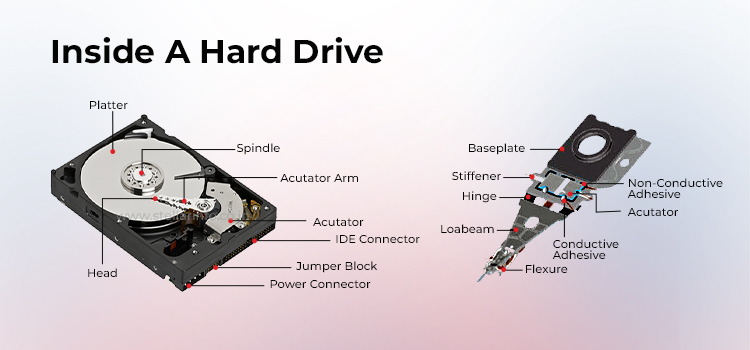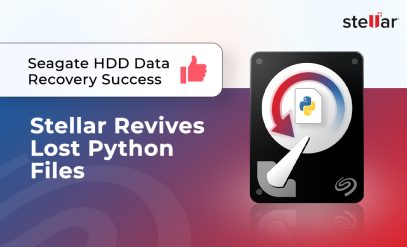Summary: Hard drives store data using spinning platters and read/write heads, which work together to write and read information. These parts move with precision to process data accurately. While newer SSDs are faster and more durable, hard drives are still widely used. That’s because they are affordable and effective for storing large amounts of data. This guide helps you understand how these components work; you can see why hard drives remain an important part of modern computing despite the rise of newer technologies.
Hard drives are the backbone of modern computing. SSDs, or solid-state drives without moving parts are a newer storage solution, but they have not replaced hard drives. This guide focuses on HDDs (hard disk drives) and explores their inner working, the science behind hard drives, and how they work.
And without any further ado, let’s get right into it.
An Introduction to Hard Drives
Hard drives are essential storage devices in modern computing, widely used for storing large amounts of data.
An SSD is a newer version of hard drive technology, but the main difference is that hard drives have moving parts, and SSDs do not. Hard drives write data to magnetic storage, using spinning platters and a “write head“, similar to how a gramophone needle works.
The science of hard drives involves coordinating various parts, such as the spinning platters and read/write heads, to manage data efficiently. Despite better and newer technologies, hard drives are popular today because they are cost-effective, and have been addressed for all of their major problems.
In the next section, we will cover the evolution of hard drive technology, from its introduction to the mature product that it is today.
The Evolution of Hard Drive Technology
Early HDDs were large, power-sapping devices that could only store a few MB of data, far from the terabyte-in-your-pocket drives of today.
A first-generation hard drive from 1950 with a platter that was four feet wide could only save 3.75 MB of data. For reference, a Western Digital hard drive can save 5 TB on a four-inch platter today.
We should also talk about the pricing of these drives. Initial hard drives in the 1950s cost about $3,500 at the time, equivalent to $30,000 today. You were effectively paying $10,000 per MB of storage. Today, with advancements in the science of hard drives, you can get a five-terabyte HDD for under $50 — that’s less than $0.009 per MB.
Modern hard drives have drastically improved speed, reliability, and storage capacity. Despite the rise of SSDs, hard drives remain essential, especially in environments where large data storage is necessary. This is because SSDs have better performance, but are also about 10 times as expensive. On average, you’d spend $0.07 for an MB of storage on an SSD versus $0.09 on an HDD.
In the next section, we’ll cover the internal components of a hard drive to understand the mechanics that make these storage devices function.
Inside a Hard Drive: Understanding the Components

To understand the science of hard drives, you must first understand the components that make up an HDD. The most important ones are:
1. Platters:

These are thin, circular disks coated with magnetic material where data is stored. They spin at high speeds, allowing data to be written and read. One HDD can have up to eight platters. Data is stored on the platters as tiny magnetic regions representing binary information (0s and 1s). The platters spin at high speeds—typically 5,400 to 7,200 revolutions per minute (RPM) in consumer drives. Higher-end drives can reach 10,000 RPM or more. The faster the platters spin, the quicker the read/write heads can access data across the disk.
2. Read and Write Heads:

These are needle-like devices that make contact with the thin spinning platters. The read/write heads, as the name suggests, read data from and write data to the spinning platters. During the writing process, the write head generates a magnetic field that alters the orientation of the magnetic particles on the platter, encoding data. In the reading process, the read head detects the magnetic orientation of these particles, converting the magnetic information back into electrical signals that the computer can understand. The heads must be positioned with extreme precision, as they move across the surface of the spinning platters and write data to it.
3. Actuator Arms:

The Read/Write heads are attached to miniature boom arms mounted on the spinning platter. This arm is known as the actuator arm because it is powered by an actuator motor. The arm moves in an arc over the platter surface, allowing the heads to access different data tracks. This is a precise operation, as the read/write head must be held in contact with the correct platter at all times, without scratching the platter or else data would get corrupted.
4. Voice Coil Motor:

This motor controls the movement of the actuator arm, ensuring the read/write heads are accurately positioned over the correct data tracks.
5. Printed Circuit Board (PCB):

Often referred to as the brain of the hard drive, the PCB manages data transfer and communication between the hard drive and the computer.
6. Spindle Motor:

Located at the center of the hard drive, the spindle motor turns the platters at speeds typically ranging from 5,400 to 7,200 RPM in consumer drives.
As you can see, there are several individual components that keep a hard drive running, each vital to its functioning. Even one of them failing can lead to total data loss, but we’ll cover that in another section. For now, let’s learn the science of hard drive processes and how they work.
How a Hard Drive Operates: The Data Process?
The Science of Hard Drives is rooted in the precise operations that allow data to be stored and retrieved. There are three main hard drive processes, the data write, the data read, and the power-on sequence. Each of these is explained below:
1. Data Writing Process:
When a computer saves data to a hard drive, the process begins with the Printed Circuit Board (PCB) receiving the data from the computer. The PCB then instructs the actuator arm to position the read/write heads over the correct location on the spinning platters. The read/write heads encode the data magnetically onto the platters by altering the magnetic orientation of tiny regions on the platter’s surface. This precise alteration of magnetic fields allows the data to be stored securely and accessed later.
2. Data Reading Process:
Retrieving data involves the actuator arm moving the read/write heads back over the correct position on the platters. The read/write heads detect the magnetic fields on the platters and convert them into electrical signals. The PCB then processes these signals and sends them to the computer, where they are translated back into the original data. This process happens incredibly fast, enabling near-instant access to stored information.
3. Power-On Sequence:
When a hard drive is powered on, the first step is for the spindle motor to spin the platters up to their operational speed, usually thousands of revolutions per minute. As the platters reach the correct speed, the read/write heads are lifted off their resting position and moved over the platters. The PCB then runs a series of checks to ensure all components function correctly before allowing data access. This sequence ensures the hard drive is ready to perform read and write operations efficiently.
These operations must work flawlessly to prevent data loss, which is why data recovery services are vital when failures occur.
Note that data recovery software exists, but that software will only work if your hard drive is functioning. If any of the above processes fail, it would point to a mechanical fault in the HDD. Only a specialized HDD Data Recovery Service like Stellar Data Recovery Services can help you get your data back from a mechanically failed hard drive.
That brings us to the end of this article on the science of hard drives and how hard disks work. If you have questions, leave them in the comment box and one of our expert team will get back to you as soon as possible.
Frequently Asked Questions
1. How long does a hard drive typically last?
The lifespan of a hard drive can vary based on usage, environmental factors, and the drive’s quality. On average, an HDD lasts 3 to 5 years under normal usage conditions. Regular backups are recommended to protect against unexpected drive failures.
2. What is the difference between internal and external hard drives?
Internal hard drives are installed inside a computer and are directly connected to the motherboard via SATA or similar interfaces. External hard drives are housed in their own enclosures and connect to the computer via USB, Thunderbolt, or eSATA, making them portable and easy to use across multiple devices. However, each functions the same, with the same internal components and processes.
3. What are the signs that my hard drive is about to fail?
Common signs of impending hard drive failure include unusual noises, slow performance, frequent crashes or freezing, corrupted files, and the inability to access certain files. If you notice these symptoms, back up your data immediately and consider replacing the drive.










